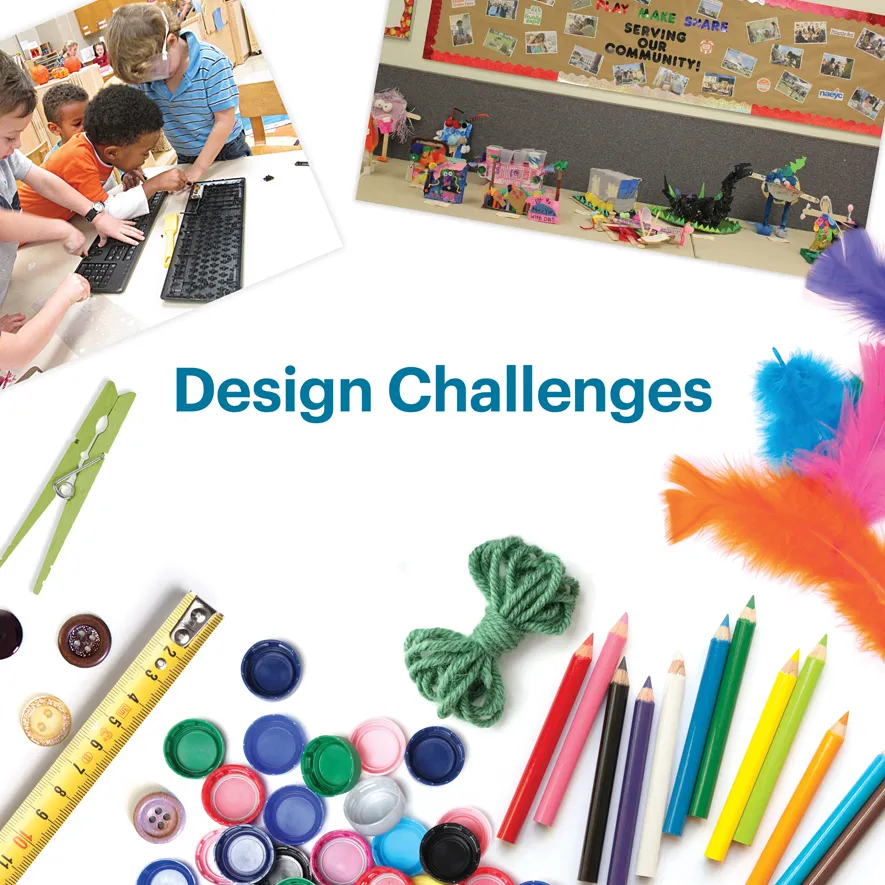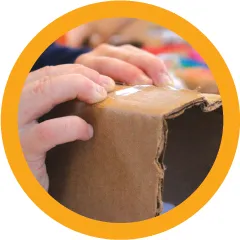
eBook - ePub
Making and Tinkering With STEM
Solving Design Challenges With Young Children
Cate Heroman
This is a test
Buch teilen
- English
- ePUB (handyfreundlich)
- Über iOS und Android verfügbar
eBook - ePub
Making and Tinkering With STEM
Solving Design Challenges With Young Children
Cate Heroman
Angaben zum Buch
Buchvorschau
Inhaltsverzeichnis
Quellenangaben
Über dieses Buch
Tinker, make, engineer—solving problems from picture books!
Can you build a sturdy house that is safe from the big, bad wolf?
Imagine your dream car. What special features does it have? What can you use to create it?
Teaching and learning STEM subjects (science, technology, engineering, and mathematics) is more accessible than ever before! Children will be inspired, delighted, and challenged as they use everyday materials and STEM concepts to design and build solutions to problems faced by characters in their favorite books. This practical, hands-on resource includes:
- 25 engineering design challenges appropriate for children ages 3–8
- Suggestions for creating a makerspace environment where children can tinker with materials, use tools to make creations, and improve on their ideas
- A list of 100 picture books that encourage STEM-rich exploration and learning
- Questions and ideas for expanding children's understanding of STEM concepts
- A planning template so you can create your own design challenges
Use engaging children's books together with the guidance and ideas in this book to extend children's problem-solving skills and creative thinking.
Häufig gestellte Fragen
Wie kann ich mein Abo kündigen?
Gehe einfach zum Kontobereich in den Einstellungen und klicke auf „Abo kündigen“ – ganz einfach. Nachdem du gekündigt hast, bleibt deine Mitgliedschaft für den verbleibenden Abozeitraum, den du bereits bezahlt hast, aktiv. Mehr Informationen hier.
(Wie) Kann ich Bücher herunterladen?
Derzeit stehen all unsere auf Mobilgeräte reagierenden ePub-Bücher zum Download über die App zur Verfügung. Die meisten unserer PDFs stehen ebenfalls zum Download bereit; wir arbeiten daran, auch die übrigen PDFs zum Download anzubieten, bei denen dies aktuell noch nicht möglich ist. Weitere Informationen hier.
Welcher Unterschied besteht bei den Preisen zwischen den Aboplänen?
Mit beiden Aboplänen erhältst du vollen Zugang zur Bibliothek und allen Funktionen von Perlego. Die einzigen Unterschiede bestehen im Preis und dem Abozeitraum: Mit dem Jahresabo sparst du auf 12 Monate gerechnet im Vergleich zum Monatsabo rund 30 %.
Was ist Perlego?
Wir sind ein Online-Abodienst für Lehrbücher, bei dem du für weniger als den Preis eines einzelnen Buches pro Monat Zugang zu einer ganzen Online-Bibliothek erhältst. Mit über 1 Million Büchern zu über 1.000 verschiedenen Themen haben wir bestimmt alles, was du brauchst! Weitere Informationen hier.
Unterstützt Perlego Text-zu-Sprache?
Achte auf das Symbol zum Vorlesen in deinem nächsten Buch, um zu sehen, ob du es dir auch anhören kannst. Bei diesem Tool wird dir Text laut vorgelesen, wobei der Text beim Vorlesen auch grafisch hervorgehoben wird. Du kannst das Vorlesen jederzeit anhalten, beschleunigen und verlangsamen. Weitere Informationen hier.
Ist Making and Tinkering With STEM als Online-PDF/ePub verfügbar?
Ja, du hast Zugang zu Making and Tinkering With STEM von Cate Heroman im PDF- und/oder ePub-Format sowie zu anderen beliebten Büchern aus Education & Early Childhood Education. Aus unserem Katalog stehen dir über 1 Million Bücher zur Verfügung.
Information
Thema
Education
Baby Bear’s Chair

LET’S LOOK AT THE PROBLEM
After a walk in the woods, the three bears return to their house to find Little Wee Bear’s chair broken, his porridge gone, and someone sleeping in his bed.
What do the three bears do about the broken chair? How do you think they could have fixed it? Have you ever fixed something that broke at home or at school? How did you do it?
MATERIALS
□ Reusable resources such as boxes, cardboard sheets and tubes, wood scraps, and craft sticks
□ Connectors such as tape, glue, a low-temperature glue gun, cardboard connectors, and brads
□ Tools such as scissors, child-safe cardboard cutters, and measuring tapes
□ Broken or nonworking items such as toys or small appliances
□ A balance scale and a 5 lb. weight
□ Paper and markers, crayons, or pencils
Safety note: Adult assistance needed in cutting cardboard
TINKER WITH THE MATERIALS
Pretend you work at a fix-it shop near the woods where Goldilocks might take Little Wee Bear’s chair to be repaired. Look at the broken things (toys and small appliances) and at the tools and materials you might use to fix them. What can you fix? Try some different connectors to hold things together. Which one seems to work best with the object you chose to fix?
STEM CONCEPTS
balance / design engineering / force / gravity / measurement / number concepts / patterning / scientific inquiry / stability

THE DESIGN CHALLENGE
Making Build a chair that stands on its own.
Engineering Build a stable chair that doesn’t wobble and can hold an object that weighs at least five pounds.
WORKING ON THE DESIGN CHALLENGE
• Think about it. How will you build the chair? What does your chair need to include? What will you do to make it stable? Draw or sketch your ideas.
Engineering. What part of Little Wee Bear’s chair do you think broke and why? What part of the chair does he sit on? What part keeps him off the floor? How can you use this information to design your chair? How will you make the chair strong so Goldilocks can’t break it?
• Build or create it. Gather your materials to build the chair. Make sure that it is strong and sturdy.
• Try it. Try to make the chair stand up on its own.
Engineering. What will you use for a five-pound weight? What is the most weight the chair will hold?
• Revise or make it better. Does it work? If it doesn’t, what can you change to make the chair better, stronger, or more stable?
Engineering. Is your chair stable (no wobbling)? Does it hold at least five pounds?
• Share. Tell someone about your chair and how you made it. Ask them if they have ideas about how to make it better.
Engineering. Test several chairs. Which one holds the most weight? Look closely at that chair and discuss with someone which features you think make it strong.
QUESTIONS AND COMMENTS
What do you think will happen if __________?
Tell me about your chair.
How much weight do you think your chair will hold?
What part do you think is the weakest? How could you strengthen that part?
BACK TO THE PROBLEM IN THE BOOK
Why do you think Little Wee Bear’s chair breaks but the other chairs do not?
How do you think your chair compares with Little Wee Bear’s chair?
GOING DEEPER
• Design a chair that reclines. What other tools and materials would you need? How would you make it?
• Use tools to take apart and/or fix a broken chair donated by a family, friend, school, or community member. What can you do to make it usable and look new again?
• What if animals could sit in chairs? How would you design and make a chair for a snake? a giraffe? a porcupine? an octopus? an ant?
• Examine different types of wheelchairs. How do they work? Interview someone who uses a wheelchair. What are their ideas for making it better? Design and make a prototype (model) of a wheelchair that helps a person do a special task or an activity.
OTHER BOOKS TO USE
A Chair for Baby Bear / Kaye Umansky, illustrated by Chris Fisher
A Chair for My Mother / Vera B. Williams
Peter’s Chair / Ezra Jack Keats
A Chair for My Mother / Vera B. Williams
Peter’s Chair / Ezra Jack Keats
Beautiful Buildings

LET’S LOOK AT THE PROBLEM
Iggy Peck began building at the early age of 2, when he built a tower from dirty diapers! As he grows, he continues to build things like a cathedral out of apples and a castle out of chalk. When he gets to second grade, his teacher forbids him to build anything more. But when the class goes on a field trip, it’s up to Iggy to rescue them all from trouble.
Why does Iggy’s teacher forbid him to build anything in class? What problem arises on the field trip? How does Iggy use his building skills to solve the problem?
MATERIALS
□ Reusable resources such as boxes, cartons, cardboard tubes, craft sticks, toothpicks, paper plates, plastic cups, pipe cleaners, wooden skewers, and drinking straws
□ Connectors such as tape, glue, brads, binder clips, rubber bands, playdough, clay, wire, and cardboard connectors
□ Tools such as scissors, measuring tapes, rolling pins, and pliers
□ Photos or magazine pictures of tall buildings in your community and other locations
□ 100 pennies
□ Paper and markers, crayo...